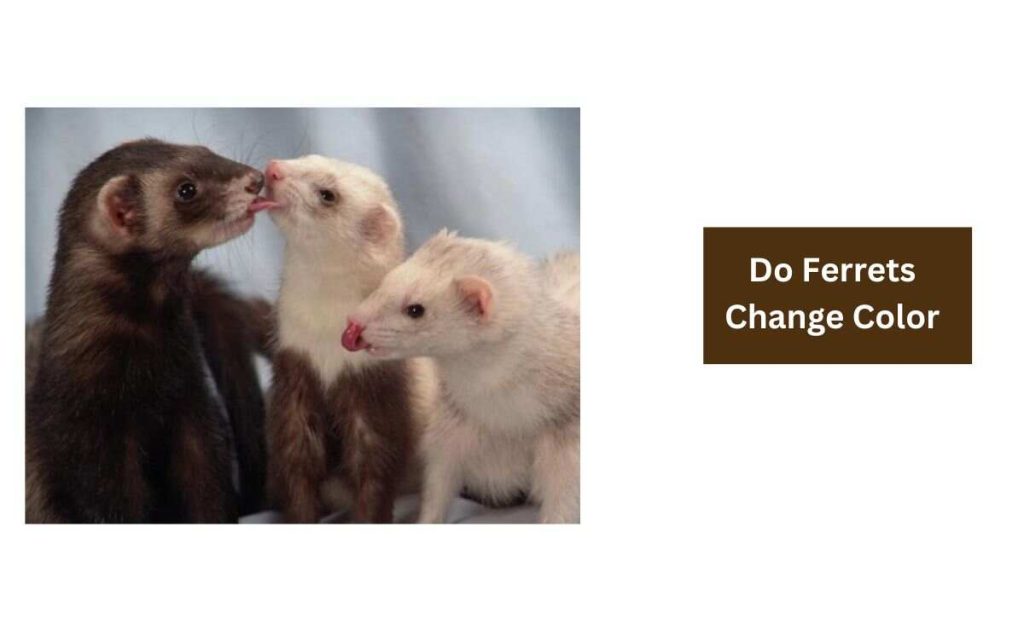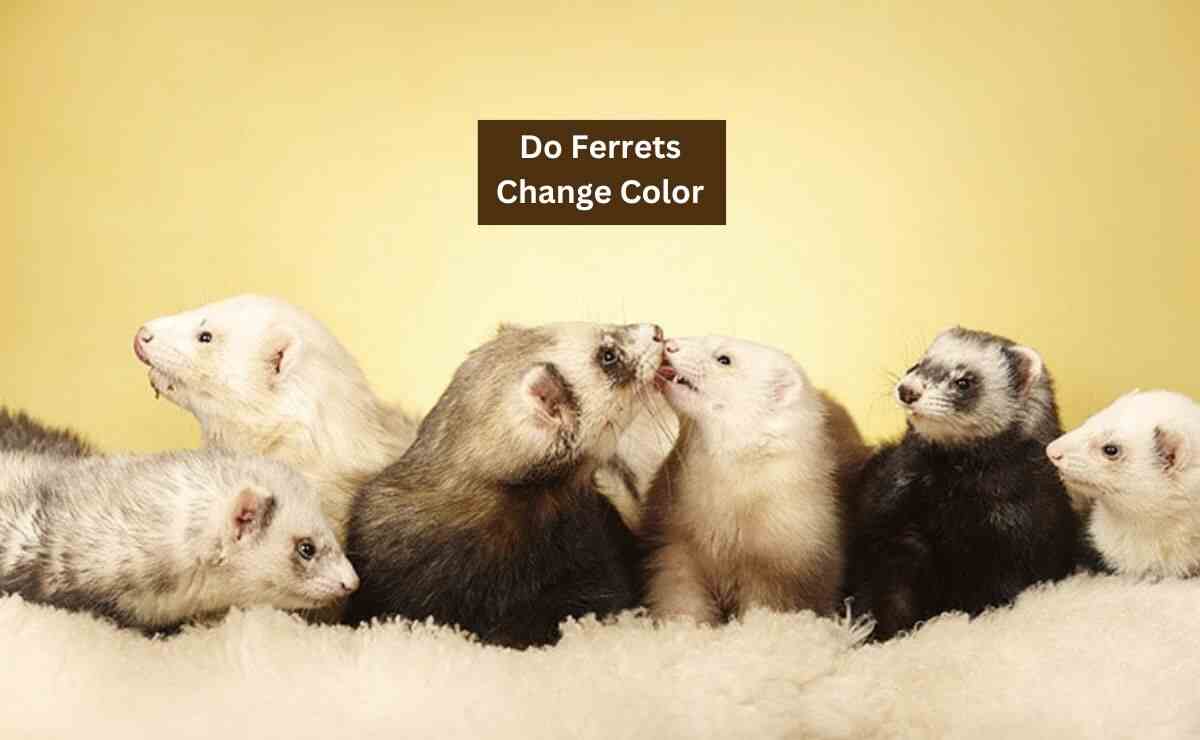Ferrets are small and energetic pets. It’s great that they are available in many colors, patterns, and unique variations. Whether the color is, all of them are so adorable. But sometimes a few ferrets start changing their coat color. So many ask: do ferrets change color?
Yes, Ferrets change color. Due to aging, dietary, changes, or environmental changes, ferrets turn in different colors. Well, many also observe behavioral changes during this phase like aggression or dietary change.
Ferret’s Coat Color Facts
Ferrets undergo significant coat changes, during shedding their baby coats and transitioning to adult coats by the age of 1. However, the environmental temperatures impact their fur density.
When it is summer, ferrets have a short, smooth, and silky coat. Until fall, they develop a longer and fuller coat. In the spring, they have thick and longer coats.
The house temperature influences the development of a ferret’s winter coat. Higher temperatures might signal summer to a ferret’s body, preventing the growth of the winter coat.
Ferret owners must give a hairball remedy during these times because ferrets ingest shedding hair as they groom themselves. A hairball can cause a gastrointestinal obstruction that might require emergency surgery to correct.
Coat changes can also impact a ferret’s color and face markings. While not all ferrets undergo these changes, it’s a normal progression due to diet and supplements.
Color patterns contribute to aging aesthetics. Albinos remain consistent, while roan or silver ferrets lighten with age. Darker patterns, like sables, show graying on their hind legs. These variations are normal, reflecting the natural aging process in ferrets.
Do Ferrets Change Color?

Ferrets are known for their unique and beautiful coat colors, but do they change color over time? The answer is both yes and no. Some ferrets are not and some change their coat color naturally as they age, certain factors can cause their fur to appear different.
Ferrets are born with a specific coat color that is determined by their genetics. This color is typically set and will remain the same throughout their lives. However, there are instances where a ferret’s fur may appear to change color.
One factor that can affect a ferret’s coat color is the seasonal changes. Some ferrets have what is known as “seasonal coats,” where their fur becomes thicker and changes in color during certain times of the year. This is most commonly seen in wild polecat ferrets and is thought to be an adaptation to blend in with their winter surroundings.
Another factor that can cause a change in a ferret’s coat color is a health issue. Illnesses or hormonal imbalances can sometimes lead to fur discoloration or patches of different colors. If you notice any drastic changes in your ferret’s coat color, you should consult with a veterinarian to rule out any underlying health problems.
Reasons For Changing Fur Color of Ferrets
Ferrets turn into various colors due to many reasons. They are:
- Shedding
This is the most common reason for changing the fur color of your ferrets. They shed their hair twice a year during spring and fall. To protect themselves, they shed and develop their fur according to the temperature.
Increased oil secretion during shedding may impart a yellowish-golden hue to the undercoat and you can observe a change in their color.
- Aging
Just as gray hair may signify wisdom in humans, changes in fur color are a natural part of the aging process for ferrets.
With a typical lifespan of 6 to 10 years, ferrets undergo normal alterations in their coat color as they age.
As ferrets aged, their coats may lighten or turn gray due to a decrease in melanin production. Melanin is responsible for imparting pigment to the skin, hair, and eyes. The aging body’s gradual reduction in melanin production contributes to these color shifts.
- Hormonal Changes
Male ferrets, especially intact ones, may experience color changes linked to hormonal fluctuations.
During the breeding season, intact male ferrets can undergo noticeable alterations in coat color due to increased hormone secretion.
- Waardenburg Syndrome
This condition relates to deafness. It manifests as a distinct coat pattern resembling a panda.
In this state, ferrets have a silver and gray coat, blue eyes, white paws, and a characteristic white stripe on the head.
- Adrenal Disease
Ferrets afflicted with adrenal disease may exhibit a yellowish-orange coat due to excess sebum production.
This condition is more prevalent in intact ferrets compared to neutered ones.
Why Do Ferrets Turn Yellow?
A white ferret exhibits a yellowish tinge for various reasons, many of which are linked to hormone imbalances that can affect ferrets of any gender or age.
While some causes are not alarming and can be addressed with proper care and grooming, others may indicate underlying health issues.
Changes in seasons, particularly transitioning to warmer weather, can trigger increased oil production in ferrets, leading to a yellowish tint on their coats.
However, frequent baths can strip away natural oils, resulting in yellowing of the fur. Alterations in a ferret’s diet, especially those high in fat, can impact hormone levels and contribute to heightened oil production.
Adrenal disease is more prevalent in older ferrets, typically between 3-7 years old, and is closely linked to sexual maturity.
Sexual maturity and hormonal fluctuations during the breeding season can cause the adrenal gland to enlarge, potentially leading to hyperplasia, where the gland disrupts typical hormone concentrations.
These are some common reasons for yellowish fur in ferrets. Some care and maintenance can improve their appearance. However, you should consult a vet if they have adrenal disease.
Do Ferrets Turn White in Winter?
If you observe changes in your ferret’s coat color, it’s natural to wonder about the reasons behind this transformation. Indeed, some ferrets undergo a shift in color during the winter season, specifically during the fall shedding process as they prepare for winter.
Ferrets can turn white in winter as they have a shedding process in the fall as they prepare for the winter season. The coat becomes lighter in shade and longer, serving the dual purpose of providing warmth and aiding in camouflage in snowy environments.
While the potential for a lighter shade exists, it’s important to note that not all ferrets undergo a complete transformation to pure white. With more than two dozen different ferret types, each possesses its own unique characteristics, contributing to variations in coat color.
Why Is My Ferret Turning Grey?
One possible cause of a ferret turning grey is the aging process. Just like humans, ferrets’ fur can change color as they get older. This is a natural occurrence and should not be a cause for alarm. The fur may become lighter or develop grey patches over time.
Another potential reason for a grey ferret is an underlying health condition. In some cases, a change in fur color can be a symptom of an underlying issue such as adrenal disease or malnutrition.
If you notice other signs of illness or a significant change in your ferret’s behavior, it is best to consult with a veterinarian to rule out any potential health concerns.
Stress can also be a factor in a ferret’s fur turning grey. Ferrets are sensitive animals, and changes in their environment or routine can cause them stress. This stress can manifest physically in the form of changes in fur color.
Ensure that your ferret has a stable and comfortable living environment, as well as providing mental and physical stimulation can help alleviate stress and potentially prevent or minimize color changes.
In some cases, genetic factors may contribute to a ferret turning grey. Certain ferret color genetics can cause the fur to change over time. While these genetic factors are not harmful to the ferret’s health, they can lead to changes in fur coloration.
Conclusion
Ferrets do not naturally change their coat color over time. Actually, there are certain factors such as seasonal changes or health issues that can cause their fur to appear different.
If you have any concerns about your ferret’s coat color, it is always best to seek professional advice from a veterinarian.
